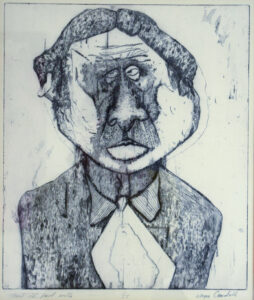By Wayne Crandell
Good Old Paul Wells is an intaglio print by Wayne Crandell. It was acquired by the LSC Arts program on January 1st, 1973. It is now located in the LSC on the 300 floor east hall. This was the first print pulled out of an edition of 25 prints total. The intaglio process being used for this portraiture is the etching process. Intaglio includes etching, engraving, drypoint, and aquatint. Intaglio differs from relief printmaking because the image to be printed is incised into the surface or plate. With relief printing the image is to be raised from the surface. With etching, it is common to use either a zinc or copper plate when creating the image. Etching uses acid to “bite” into the metal surface. Once the plate has been beveled on the edges so that it isn’t sharp, which could cause the paper to rip when printing, a ground is applied to the plate with a brush. Once the ground is dry, after a few hours, then sharp tools are used to scratch into the ground. The areas that are removed will be the areas that accept ink during the printing process. After this, the prepared plate is dropped into the acid bath to allow the acid to “bite” into the plate. Once the plate is removed from the acid, it is cleaned with acetone or paint thinner. Now the plate is ready to be printed. Ink is rolled onto the plate then it is set on a hot plate where the ink can evenly distribute itself into the etched areas. After the inking process is complete, the plate is gently wiped with cheese cloth so that the majority of the ink is where the image has been created. Now the plate is set on the press with a damp piece of rag stock paper over it. The plate is rolled gently and evenly through the press. The paper then can be lifted up to reveal the etched print. It must be hung to dry. Tony has been creating art since his elementary eras, working with pencil sketching, collages, watercolor, and oil paintings. In recent years, Tony has been working on both 3D digital modeling and painting along with his 2D work. This is a quote from his biography on his website, “Several of his work is compared to a puzzle whose code needs to be discovered; yet he invites the audience to provide their own interpretation of his art.” He has focused on digital painting and animation since 2012. His work draws on dreams, symbolism, and the universal unconscious. Much of his work focuses on the supernatural, irrational, and mysterious. By emphasizing the absurd and turning reality upside down he hopes to wake up viewers from their established perceptions and the fact that they have become accustomed to certain politics, ideologies, and propaganda.


